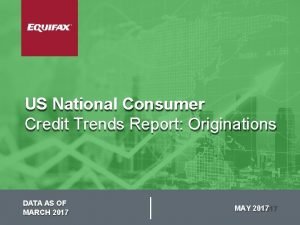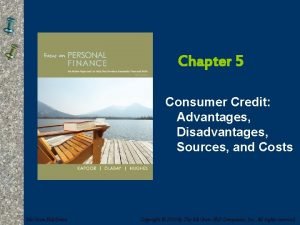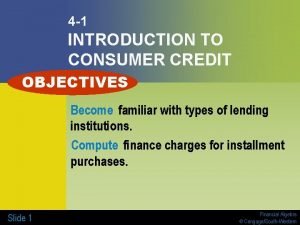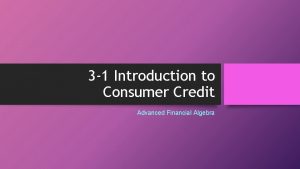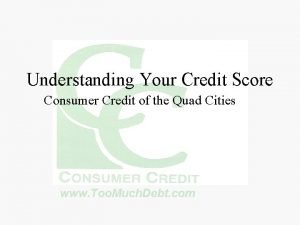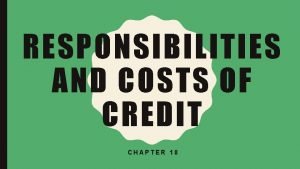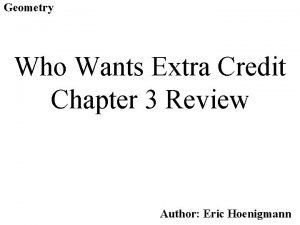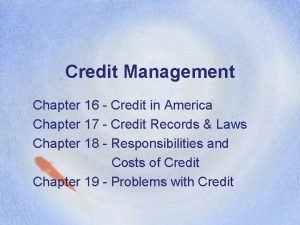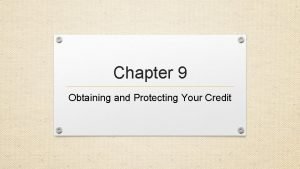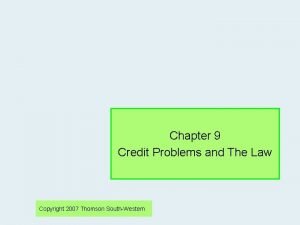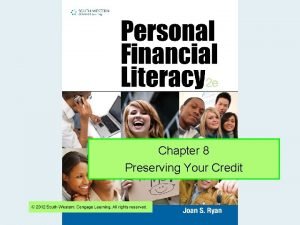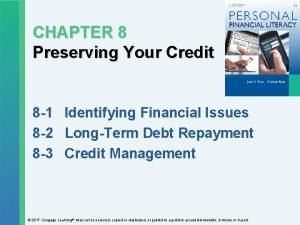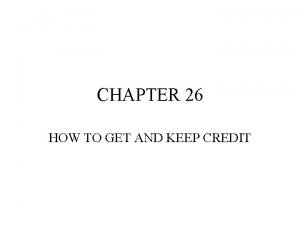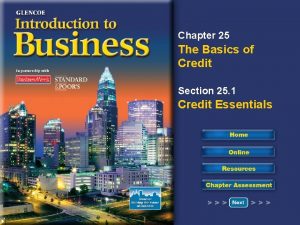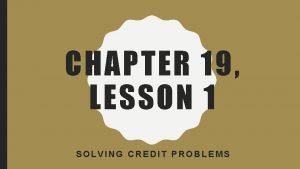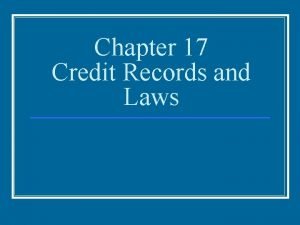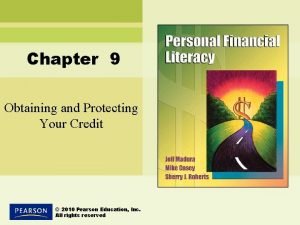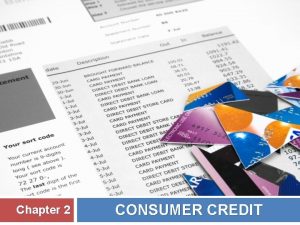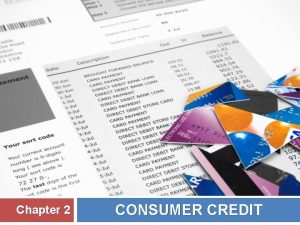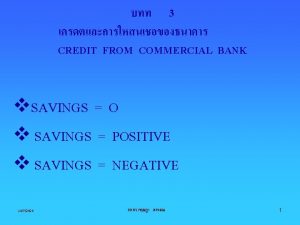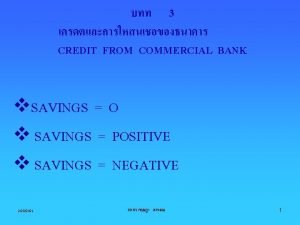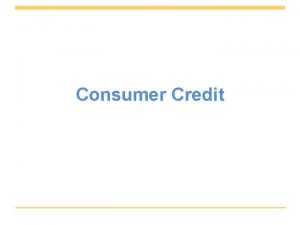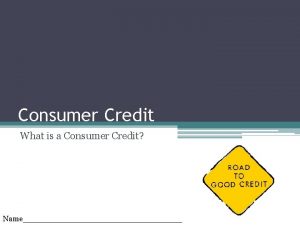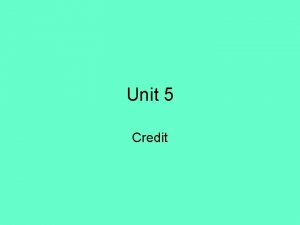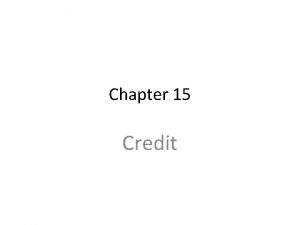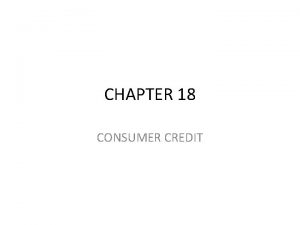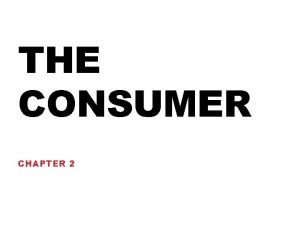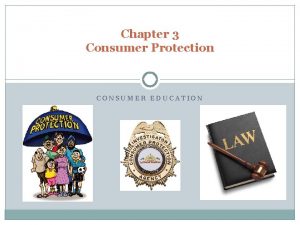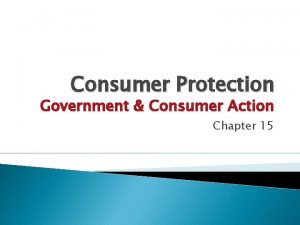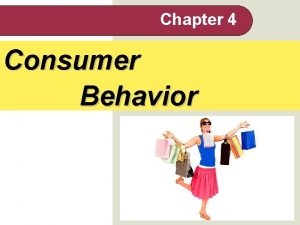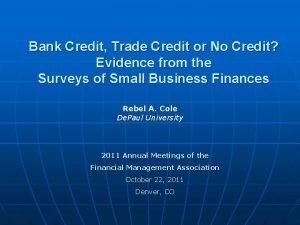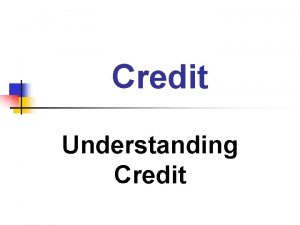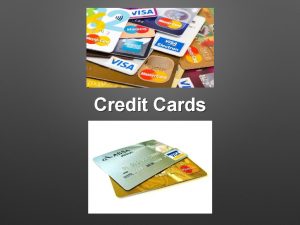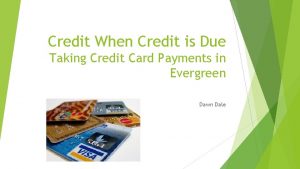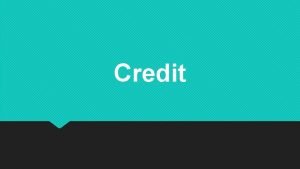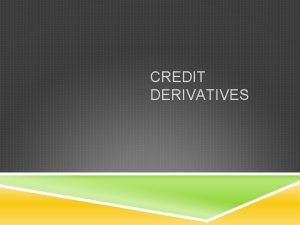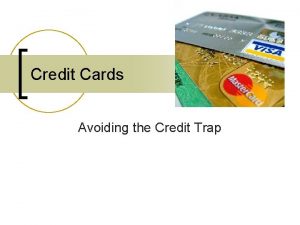CHAPTER 6 CONSUMER CREDIT CHAPTER 6 CONSUMER CREDIT

























- Slides: 25

CHAPTER 6 CONSUMER CREDIT

CHAPTER 6 – CONSUMER CREDIT • Section 1 – What is consumer Credit? • Credit – the arrangement to receive goods, services, or cash now, and pay for them later • Consumer Credit is credit for personal use, and what we are going to talk about • Examples include • Credit Cards • Installment Loans • Mortgages • Student Loans • Sometimes using credit is necessary, but it comes with risk • If you don’t pay, your possessions can be taken from you • You will have to pay penalties, fees, and interest if you don’t pay

CHAPTER 6 – CONSUMER CREDIT • Credit Uses and Misuses • Credit allows you to spend more now, but reduces your future spending • Sometimes this is necessary, such as buying a home, or paying for college • Sometimes it is not… do you really need a new car to get to work • Do you really need the latest i. Phone? • • The average credit card debt person (as of 2018) is $4, 453, with $808 billion total owed on credit cards What should you consider before using credit? • Do you have cash for a down payment? (Most large purchases require) • Do you want to use your savings instead? (Emergency fund? ) • Can you afford the item? (Or are you trying to live above your means? ) • Could you use the credit in a better way? (Home, vehicle? ) • Can you put off buying the item for a while? (skip the i. Phone this year, wait another year? ) • What are the costs of using credit? • Interest!

CHAPTER 6 – CONSUMER CREDIT • Advantages of using credit • You can pay for goods and services now when your funds are low (buying a home, paying for college, getting a car to get back and forth to work) • You may be required to use a credit card when getting a hotel room or renting a car, because of incidentals • Most will place a large “hold” on your account that could cause you to overdraft your account • Can combine many purchases that you make, giving you one monthly payment • Can help you with budgeting as well (as long as you don’t overspend) • Safer to travel and shop, you’re not carrying large amounts of cash, which is unrecoverable, whereas a card can just canceled if lost/stolen • Low liability ($50) if lost of stolen, even though most don’t enforce • If (and it’s a HUGE IF), you use it responsibly, future lenders will view you as a better borrower, which will lower your interest rates • On a $300, 000 house, a 1% change in interest rate can save you over $50, 000 over the life of the loan!

CHAPTER 6 – CONSUMER CREDIT • Disadvantages of Credit • It costs money, in the form of interest, to borrow money • Can be upwards of 20 -30% on credit cards! • People spend more money when they use “plastic” (debit OR credit) rather than cash • There is less “pain” associated with the transaction • If you fail to repay the loan • Future loans will be more expensive • Your stuff may be repossessed (taken back) • You may have to declare bankruptcy • Credit does not increase your buying power (in fact it reduces it, since you have to pay interest) • Huge risk to “impulse buy” when you see something “on sale”, since it doesn’t register as “real money” until the bill comes… and by that time, you can’t give up the item • Approach credit with caution • Used wisely, it can help you out, save you money • However, it is very, very easy to get yourself into trouble with it. (and they are hoping you do, that’s how THEY MAKE MONEY!)

CHAPTER 6 – CONSUMER CREDIT • Types of Credit • Closed End Credit • One time loans that you pay back over a specified amount of time • Includes: • Mortgages, Car Loans, Student Loans, Installment Loans • Open End Credit • Certain limit on how much you can borrow, most people don’t use all of it • The limit you can borrow is called your “credit limit”, and you will be given a “line-ofcredit” for a certain amount • Includes • Credit Cards, Department Store Cards, Home Equity Line of Credit (HELOC)

CHAPTER 6 – CONSUMER CREDIT • Where do you get Credit? • Loans • The cheapest loans (at least from a money standpoint) are from Friends and Family • There may be “strings attached”. Money has ruined more than 1 friendship • The average cost loans can be gotten at commercial banks and/or credit unions • This is where you should do a majority of your borrowing • HELOC’s use the equity in your home to borrow so it’s asset backed which makes it cheaper • The most expensive ways to borrow include: • Department store cards • Credit Cards • Finance companies (Pay-day advance, these are TERRIBLE, YOU SHOULD NEVER, USE THESE, UNLESS IT IS LITERALLY LIFE OR DEATH)

CHAPTER 6 – CONSUMER CREDIT • Credit Cards • Users who pay their bill in full each month are called convenience users • This is about 25% of all borrowers • Users who do not pay their bill in full each month are called borrowers • This is about 50% of all borrowers • The remaining 25% are sometimes convenience users and sometimes borrowers • You usually receive a grace period, which is a period of time in which no finance charges (interest) is accrued on the balance • Some credit cards have annual fees as well

CHAPTER 6 – CONSUMER CREDIT • Section 2 – The Costs and Methods of Obtaining Credit • The person/bank that is loaning you money is going to look to see if you can afford the loan • They are going to look at your financial situation to determine if you can borrow the money • So, what are they going to look at? • Debt-to-income ratio • They will divide your debt payments (omitting your house) by your monthly income • This should be less than 20%, but ideally, much lower • They will also look at the 5 C’s of credit • 1. Character: Will you repay the loan? • Are you trustworthy and stable? (How long have you had a job? Lived in the area? ) • Have you used credit before? (How did that go? )

CHAPTER 6 – CONSUMER CREDIT • 2. Capacity: Can you repay the loan? • How much money do you make? • How much debt do you have? • 3. Collateral: What do you own if you don’t repay the loan? • What assets do you have to secure the loan? (Home, Car, Boat) • Do you have any other assets? (Savings, 401(k)) • 4. Credit History: What is your credit history? • Do you pay your bills on time? • Have you ever filed for bankruptcy? • Will use your Credit Rating – a measure of your ability to make credit payments on time

CHAPTER 6 – CONSUMER CREDIT • 5. Capital: What are your assets and net worth • Looking as your assets, and liabilities • Credit Scores and Credit Reports • There are 3 major credit bureaus that collect and distribute your credit information • Experian • Trans. Union • Equifax • These companies make money by selling your information to creditors • What information is in your credit file? • Employer, Position, Income for you and your spouse • Previous addresses for you and your spouse • Do you own or rent your house • Any NSF checks • History of EVERY SINGLE loan/payment you have ever had

CHAPTER 6 – CONSUMER CREDIT • Credit Scores • The most common is your FICO score (Fair, Isaac & Company) • They look at the following • Payment History (35% of score) • Amount Owed (30%) • Length of History (15%) • New Credit (10%) • Types of Credit (10%) • Scores range from 350 -850, with 850 being the best. • Anything over 700 is considered good, and 750+ is excellent

CHAPTER 6 – CONSUMER CREDIT

CHAPTER 6 – CONSUMER CREDIT • Fair Credit Reporting • You have a right to have inaccurate information removed from your report • To do so, you must see your report so… • You are able to receive, FOR FREE, a copy of your credit report once per year from each of the 3 major bureaus • STRONGLY recommend that you start doing this immediately • The website to use is www. annualcreditreport. com Any other site that says they give “free” credit reports is a credit monitoring service and will require you to sign up for some service • Negative information in your report is limited to 7 years. (other than chapter 7 bankruptcy, which is 10)

CHAPTER 6 – CONSUMER CREDIT

CHAPTER 6 – CONSUMER CREDIT • The cost of Credit • Finance Charge is the monthly fee that you pay to use the credit • Will use the APR (Annual Percentage Rate) to calculate, this must be explicitly stated • Trade offs of credit • A longer term will result in lower monthly payments, but you will pay more in interest • Lender Risk – For a fixed rate loan, the lender is taking a risk loaning you the money, what affects the interest rate? • A large down payment will typically lower interest rate (less risk of default) • A shorter term will typically lower interest rate (less inflation risk) • A higher credit score will typically lower interest rate (less risk of default) • Taking a variable rate may lower the interest rate (less inflation risk for the bank, MORE FOR YOU!) • Securing the loan will lower the interest rate (less risk of default, bank gets something if you don’t pay) • This is an asset backed loan (Home mortgages, car loans, and HELOCs are this) • You can also purchase secured credit cards

CHAPTER 6 – CONSUMER CREDIT • Calculating the Cost of Credit • Most use the average daily balance method • So if you make multiple payments a month, can actually reduce your interest • Truth in Lending act • Must state the true APR • For a closed-end loan, will state total interest paid • Credit cards will show payments for minimum payments, and what you’d need to pay off the loan in 3 years • Will also state the total cost of each

CHAPTER 6 – CONSUMER CREDIT

CHAPTER 6 – CONSUMER CREDIT • Credit & Equal Opportunity • Equal Credit Opportunity Act • Cannot be denied credit based on your age • Cannot have an account closed just because you reach a certain age • Public Assistance • Cannot be denied a loan because you are on Social Security or other assistance (as long as you have the means to pay) • Housing Loans • No Redlining, which is discrimination based on who live in the neighborhood • In the ‘ 70’s it was common for banks to deny loans to African American families who wanted to buy homes in predominately “white” neighborhoods • As with most discrimination acts, also covers Age, Sex, Race, Nationality, Sexual Orientation, Marital Status, etc…

CHAPTER 6 – CONSUMER CREDIT • Section 3 – Protecting Your Credit • Billing Errors & Disputes • Notify the creditor in WRITING • Pay the portion of the bill not in question • Creditor must acknowledge you letter in 30 days, and respond within 90 days. • If you buy an item that is defective… and you’ve made an effort to return, but the store won’t accept, a credit card may help, as they can withhold payment • Having your credit card information stolen (or your identity stolen) is a big concern today. What can you do to protect yourself? • 1. Shred (or burn) all personal documents that have account numbers, addresses • 2. Make sure your card is returned to you (best to not let it out of your sight) • Restaurants?

CHAPTER 6 – CONSUMER CREDIT • 3. Keep a record of your Credit Cards, Debit Cards, and other numbers, as well as the phone numbers to call and cancel • Guess where the number to call to cancel a credit card is? ON THE CARD! • 4. Use a different password for each website (or use a password manager) • 5. NEVER, EVER write your PIN number on your card • 6. Keep your browser/operating system up to date. Make sure the website uses https: // on its sites • The ‘s’ is for secure, which means the information is encrypted • 7. Use cellular networks and protected Wi-Fi. DO NOT USE PUBLIC COMPUTERS/Wi-Fi FOR ANY FINANCIAL TRANSACTIONS. • It’s very, very easy to capture Wi-Fi transmissions, on a public network • 8. Diligently check account for suspicious purchases • 9. Stop filling out the viral posts on FB/Twitter/Instagram for “What is your superhero name? ” Based on your birthday, pets name, childhood street etc. • These are used as the security questions if you “forget your password”, and these are used by hackers to get that information

CHAPTER 6 – CONSUMER CREDIT • Cosigning A Loan • If you co-sign a loan, you are agreeing to be responsible for payment if the original person cannot pay • YOU ARE TAKING A RISK THAT A PROFESSIONAL LENDER WON’T TAKE – risky! • Student Loans • How do you pay for college? • FAFSA – Free Application for Federal Student Aid • If you want to receive any financial aid, you MUST fill this out • Federal Direct Loans • Stafford Subsidized Loans – No interest is charged until AFTER you are out of school for 6 months (best option!) • Stafford Unsubsidized Loans – Interest accrues while you’re in school (2 nd best option!) • Private Student Loans • Loans taken out through a bank or credit union, or other credit company (usually require a cosigner)

CHAPTER 6 – CONSUMER CREDIT • Section 4 – Managing Your Debts • What are some warning signs that you are in financial trouble? • 1. You only make the minimum monthly payments on your credit cards • 2. The total balance on your credit cards goes up each month • 3. You miss payments or are late • 4. You use savings to pay for essentials • 5. You borrow money to pay off old debts • 6. You exceed the limits of your credit cards • 7. You’ve been denied credit because of a bad credit report • Debt Collection • Fair Debt Collections Practices Act • Can’t threaten you, call at unreasonable hours, etc…

CHAPTER 6 – CONSUMER CREDIT • Financial Counseling Services • Most financial institutions offer financial counseling services (many for free) • Consumer Credit Counseling Services is a federal, nationwide network to help people who are unable to manage their money • Bankruptcy • Last resort • The legal process in which the assets of the debtor are distributed among the creditors • Two types • Chapter 7 – (straight bankruptcy) • Most of your assets are sold to pay off debts • Some are protected, like Social security, and unemployment benefits • The net value of your home, vehicle and household goods as well

CHAPTER 6 – CONSUMER CREDIT • Some debts are not forgiven • Alimony, Child Support, Fines, Student Loans • Any criminal debts from fraud, DUI’s or other crimes • Chapter 13 • Make a plan with a bankruptcy judge on how to pay off your debtors over time • Get to keep most of your assets • Will completely give up your right to use credit, accounts will be closed • Both bankruptcies will have a SEVERE impact on your credit score, and future credit will be EXTREMELY difficult to obtain.
 Energy pyramid
Energy pyramid This can be avoided by giving credit where credit is due.
This can be avoided by giving credit where credit is due. Equifax national consumer credit trends report
Equifax national consumer credit trends report Consumer credit advantages and disadvantages
Consumer credit advantages and disadvantages Introduction to consumer credit 4-1
Introduction to consumer credit 4-1 3-1 introduction to consumer credit
3-1 introduction to consumer credit Consumer credit of the quad cities
Consumer credit of the quad cities Greenfly carnivore
Greenfly carnivore Consumer diversity in consumer behaviour
Consumer diversity in consumer behaviour Consumer research in consumer behaviour
Consumer research in consumer behaviour Characteristics of consumer behaviour
Characteristics of consumer behaviour Consumer markets and consumer buyer behavior
Consumer markets and consumer buyer behavior Chapter 18 responsibilities and costs of credit
Chapter 18 responsibilities and costs of credit In geometry
In geometry Chapter 16 credit in america
Chapter 16 credit in america Chapter 9 obtaining and protecting your credit
Chapter 9 obtaining and protecting your credit Chapter 9 credit problems and laws
Chapter 9 credit problems and laws Preserving your credit
Preserving your credit Preserving your credit
Preserving your credit Chapter 26 how to get and keep credit worksheet answers
Chapter 26 how to get and keep credit worksheet answers Chapter 25 the basics of credit
Chapter 25 the basics of credit Chapter 10 problems with credit
Chapter 10 problems with credit Chapter 17 records
Chapter 17 records Chapter 9 obtaining and protecting your credit
Chapter 9 obtaining and protecting your credit Extra credit chapter 15
Extra credit chapter 15 Responsibilities of a consumer
Responsibilities of a consumer


